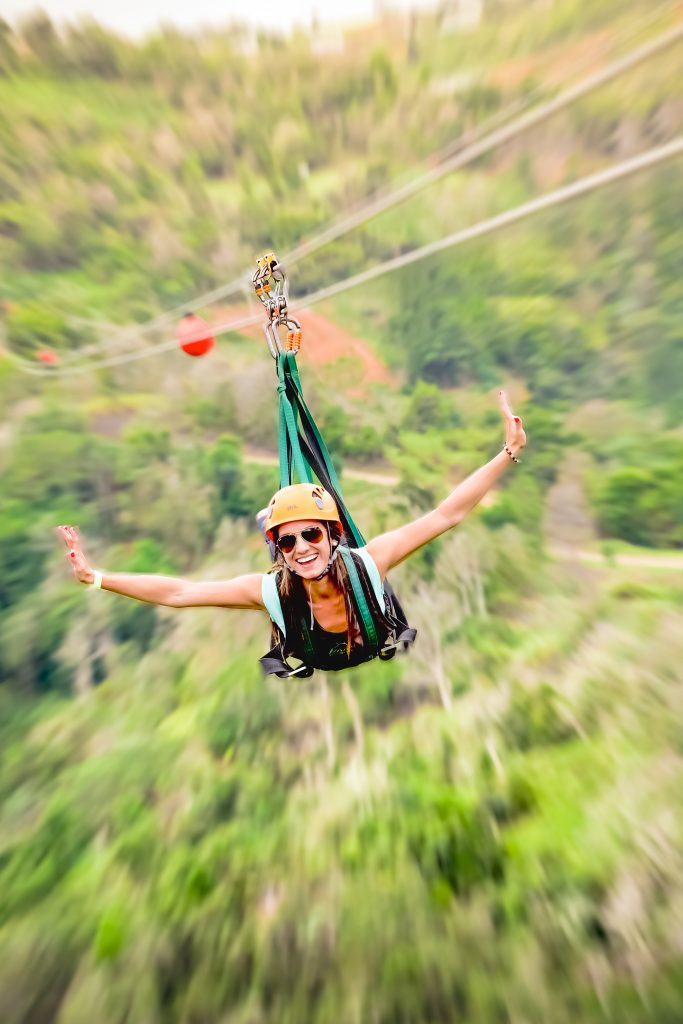Skift Take
Puerto Rico tourism, bolstered by Airbnb when hotels were shut, has had a noteworthy comeback. But if travel and living have blended, then the island's fiscal and political woes can't be overlooked.
Puerto Rico tourism is as hot as a breezeless late-morning in June on the island, but it also faces long-term challenges that could chill the narrative.
With much of the work divided between the private sector-led Discover Puerto Rico and the decades-old, government-run Puerto Rico Tourism Company, Puerto Rico tourism eclipsed pre-pandemic marks in 2021 on airport arrivals, non-resident visitor spending, lodging taxes generated, and hotel revenue per available room, which was 124 percent higher than the U.S. average that year.
Figures from the first four months of 2022, including hotel average daily rates of $305, which amounted to a 35 percent year-over-year increase, showed nothing if not acceleration in the island’s tourism metrics.
“In 2021, once the restrictions were relaxed, it was off to the races,” Brad Dean, the CEO of Discover Puerto Rico, told Skift.
All of that came despite a tumultuous last half-dozen years.
In 2016, the U.S. Congress appointed a financial oversight board for Puerto Rico that still dictates much of the island’s finances, and cut services, including teachers’ pensions several years later. A Zika outbreak took hold in 2016, as well. Hurricanes Maria and Irma devastated the island in 2017, and frequent blackouts are a nagging reminder to this day that Puerto Rico still hasn’t fully recovered. Street protests led to the ouster of the governor in 2019, and three weeks of earthquakes starting in early January 2020 rattled the island’s already fragile infrastructure.
And, then came the pandemic.
Dean said Discover Puerto Rico retooled during the first months of the pandemic because he knew travel would be back — eventually. “We did get to a point where we just didn’t have enough work for everybody, but for the most part, we kept our team intact,” he said. “We wanted to keep the brand top of mind. So 2020 really ended up just being a year where we pushed the pause button on the progress that was already under way.”
The progress and setbacks in Puerto Rico are a useful guide for other destinations struggling to make their way back from the depths of the pandemic, shining a light on how to traverse a travel industry now forced to stay nimble while meeting travelers’ new expectations.
Meanwhile, while not a Puerto Rico-specific issue, there are early signs that U.S. consumers — and perhaps others — are cutting back on travel and dining as inflation rages.
You Can’t Separate Tourism From Puerto Rico’s Colonial Status
With digital nomads wandering the earth and if barriers have indeed broken down between travel and living, as articulated by Airbnb’s Brian Chesky and Skift’s Rafat Ali, among others, then it is fair to say the island’s tourism must coexist with the tax breaks that American mainlanders can wrangle in Puerto Rico that are unavailable to Puerto Ricans, the sentiment that Airbnb is dominating what otherwise might be reasonably priced rental housing for locals, unchecked development in environmentally sensitive locations, and the fact that the island’s 78 municipalities might be divided between tourism haves and have-nots.
Then throw into the mix the fact that the island is officially a U.S. territory, but actually is a colony of the U.S. where Puerto Rican residents, who are U.S. citizens and have served in the U.S. armed forces in Vietnam, Afghanistan and Iraq, can’t vote for U.S. president. The U.S. grabbed Puerto Rico after invading the island in 1898 at the tail end of the Spanish-American war.
Because of the Jones Act, the island can’t import food and goods from U.S. ports unless it comes in a ship built in the U.S. and is mainly staffed by Americans. Since most of Puerto Rico’s imports are from U.S. ports, this Jones Act requirement drives up prices.
Crystal Díaz, who hosted the Skift team last Wednesday night at the Jajome Terrace farm-to-table restaurant in Cayey during a company retreat, told us: More than 80 percent of Puerto Rico’s food is imported despite hundreds of thousands of acres of potential farmland laying fallow.
Our farm-to-table host tonight in Cayey, PR, Crystal Diaz, telling us that economics, & lack of a food policy means 85 percent of island 🇵🇷food imported w/ 600,000 abundant acres of rich farmland. % in 1940s? 60 % @skift Retreat pic.twitter.com/nB0SRL5YpK
— Tom Lowry (@lowrytom) June 14, 2022
Puerto Rico’s tourism bodies don’t have the mandate or power to fix all of the island’s structural and decades-old issues, but some of them fall within their portfolios. The Puerto Rico Tourism Company, for example, shares some of the destination management responsibility with government agencies.
The Good and the Bad of Puerto Rico Tourism
Hector Pesquera is a retired family physician who splits his time between San Juan and Puerto Rico’s Culebra island, where his son runs a guest house, Hostal Casa Culebra. He said the majority of tourism is good, and it’s especially important in Culebra for the water taxis, restaurants, and bed-and-breakfasts.
In a separate interview, his son Sergio Pesquera, said the biggest problem with Culebra tourism is it is very difficult to make a ferry reservation to get there. The ferry websites often shows tickets are sold out, “and if you call no will answer,” he said, adding that tourists aren’t allowed to bring their cars like they were before the pandemic.
Hector Pesquera said Airbnb has had a positive impact on Culebra.
However, tourism has a negative impact when travelers don’t safeguard the island’s natural resources, Hector Pesquera said. A minority “comes just to mess things around,” he added.
Hector Pesquera said when people from U.S. states move to Puerto Rico to extract certain tax exemptions and “buy everything they can,” that’s not good for the island.
A Centro de Periodismo Investigativo investigation — it’s the same group that uncovered the homophobic chats that led to the 2019 ouster of Governor Ricardo Rosselló — found last year that Act 22 tax incentives for non-Puerto Rican investors that were geared to generate job growth and other benefits for the local economy “never materialized.”
“From being an instrument to attract millionaires, and foreign investment, Act 22 went on to become a haven for cryptocurrency fans, YouTube personalities and consultants,” the story said.
Puerto Rico Tourism Gets a New Structure
How did Puerto Rico tourism get to this juncture?
In 2017, six months before Hurricane Maria, the Puerto Rican government revamped its tourism board structure. It created privately led Discover Puerto Rico to assume and supplement some of the work of the decades-old, government-run Puerto Rico Tourism Company. The latter body now handles tourism marketing within Puerto Rico, is in charge of destination management, and oversees much of the island’s relationships with, and financial incentives for, airlines and cruise lines.
Discover Puerto Rico took over marketing Puerto Rico tourism outside the island and is in charge of meetings and conferences.
One of the ideas behind the change was to avoid the lack of strategy consistency and the constant revolving door among Puerto Rico’s tourism leadership because when tourism was solely government-run that meant there was executive turnover with each new occupant in La Fortaleza, the governor’s official residence.
Puerto Rico hasn’t reelected a governor since the 1990s so every few years the leadership of the Puerto Rico Tourism Company, which previously headed all of the island’s tourism marketing, got overturned, just as it did in 2021 when Carlos Mercado Santiago replaced Carla Campos in the top spot with the election of a Governor Pedro Pierluisi.
The inconsistency over the years led to a Puerto Rico tourism identity crisis. Just what was Puerto Rico’s tourism identity and what was the strategy if the branding was ever-changing?
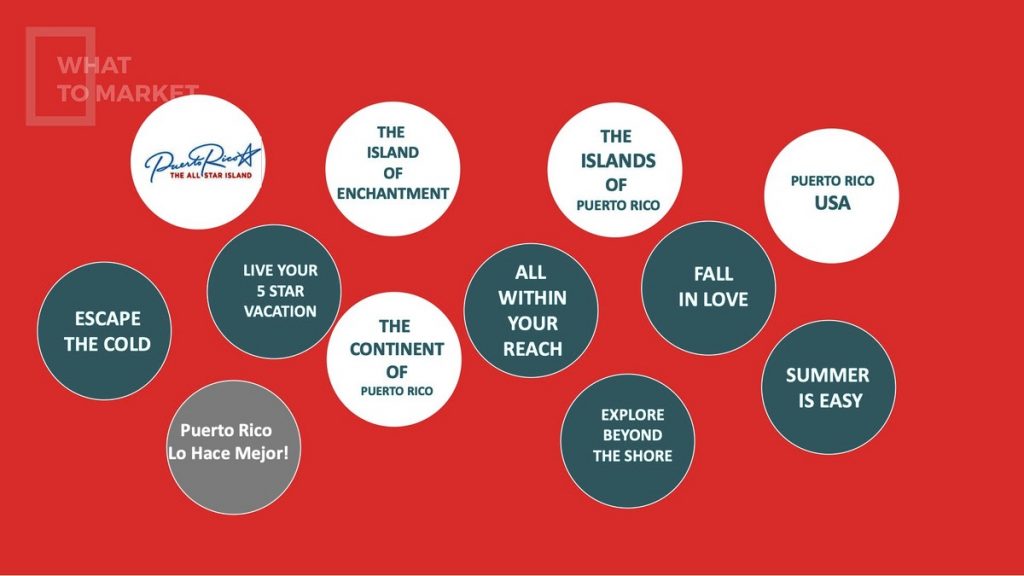
Consider the Puerto Rico Tourism Company’s marketing slogans over the years. They ranged from Escape The Cold to Summer Is Easy and The Continent of Puerto Rico and Puerto Rico USA. Wait, is Puerto Rico a continent or part of the USA? Add to the mix Fall in Love, The Island of Enchantment, Live Your 5 Star Vacation, and Explore Beyond the Shore.
Unlike those mixed messages, Dean of Discover Puerto Rico hopes its recently launched Live Boricua marketing campaign will have staying power.
The campaign emphasizes not just Puerto Rico’s beaches and places to visit, but the faces of the Puerto Rican people in all of their diversity, he said. Puerto Ricans call themselves Boricuas; the name comes from the Tainos, Puerto Rico’s native inhabits, who called the island Borinquén. Puerto Ricans are a multicolored mash with Taino, Spanish, and African roots.
Dean said Discover Puerto Rico started planning the campaign under the premise that it had to distinguish Puerto Rico from its Caribbean and U.S. mainland competitors because most islands have plenty of beautiful beaches, and so do other destinations. He said the campaign emphasized experiences for active-minded travelers, as well as Puerto Rico’s rich history and culture, as well as destinations beyond the San Juan metro and eastern corridor.
Some of the marketing urges visits to Ponce in the south and the bioluminescent bay in Lajas a little further to the west. Both take at least two hours by car from San Juan. The Toro Verde adventure park in the central portion of the island is another point of interest.
The following chart from Tourism Analytics shows Puerto Rico ranking second behind the U.S. Virgin Islands in the Caribbean in terms of 2021 non-resident stopovers as a percentage of 2019’s numbers at 103.2 percent. The Puerto Rico figures tallied non-resident hotel registrations, but much of Puerto Rico’s tourism comeback involved non-hotel short-term rentals.
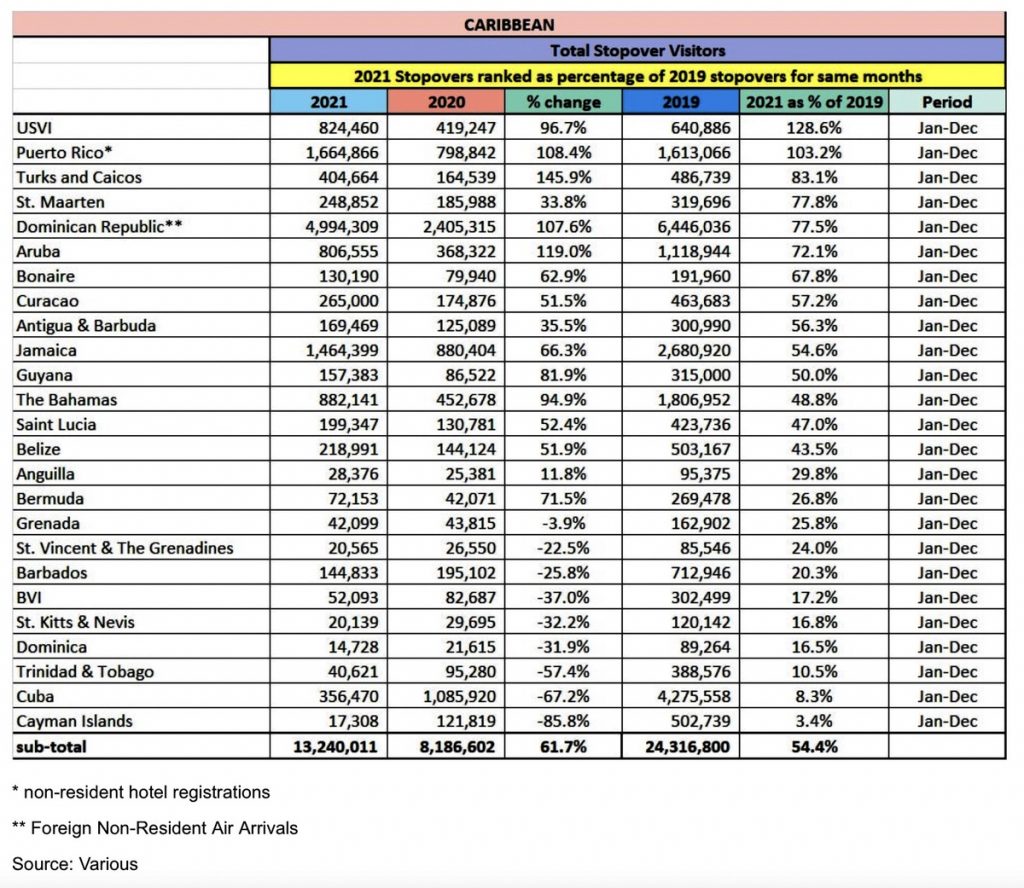
Arrivals into San Juan’s international airport from January to April 2022 exceeded 1.6 million, a 6.3 percent increase compared with the previous record, according to Aerostar Airport Holdings, which runs the airport.
While the long-term success of the Live Boricua campaign, which launched on digital channels earlier this month in the UK, Germany, Spain, Canada, and Colombia, remains to be seen, Dean thinks with it Puerto Rico tourism has found an identity to build on.
“If you think about it, I can’t say that we thought of Live Boricua four years ago, but it’s become a natural extension into that brand definition, where now we’re emphasizing not only the unique cultural heritage of the island and the unique experiences, but also the uniqueness of the people,” Dean said.
Tourism’s at Times Heavy Footprint
Amelia Barbosa works as a bartender in a beachside bar/restaurant in Rincón, Puerto Rico, on the island’s northern west coast about 90 miles from the San Juan metro area. Asked about the benefits of tourism, Barbosa said, “it’s complicated.”
Some tourists in the San Juan area behave badly, Barbosa said, and the ones who venture out of the metro area to the west coast to towns such as Rincon, Aguadilla and Cabo Rojo, don’t tend to stay very long.
“The Puerto Ricans are literally selling everything,” Barbosa said, referring to real estate and the development of Airbnbs. She said it is very difficult for Puerto Ricans to afford to buy a house.
“Americans are benefitting from everything,” Barbosa said, referring to residents of the 50 states as opposed to Puerto Ricans, who are likewise U.S. citizens. “It is very difficult to deal with that. It’s very bad.”
Felix Salas, who was born in Puerto Rico and lived here for more than 30 years, overheard the conversation and invited me to join him at the Rincon bar.
He agrees with Puerto Ricans who are angered by developers who sometimes get carte blanche to build in environmentally sensitive areas, without much government intervention.
“That is true to a certain extent,” said Salas, who works as a surveyor as it relates to land use management for a U.S. government agency in Massachusetts. “Not 100 percent, but it’s something that’s happened for a very long time. Many people either built illegally or the government agencies in charge turned a blind eye and that’s well-known.”
Salas said a movement is under way among Puerto Ricans to push the government to safeguard the island’s natural resources.
For example, one Puerto Rican independence activist, @chimeraelf, recently pointed to the problem, tweeting a series of photos depicting Airbnb properties built on beaches, allegedly impeding legally guaranteed public access to the surf and sands, and some of the homes tread on environmentally sensitive beach turf.
Airbnb played an outsized role in Puerto Rico’s tourism recovery. In the years after Hurricane Maria, when many of the island’s hotels were shuttered, Airbnb properties filled much of the gap and more. In the first four months of 2022, Puerto Rico’s hotel revenue jumped 78 percent year over year, and short-term rental revenue climbed 55 percent, according to STR and AirDNA, respectively. The average daily rate for hotels was $305, a 35 percent increase, and was much higher than the U.S. average.
There is some resentment on the island against Airbnb, especially when locals search for places to live among rising rents, and a chunk of housing is reserved for Airbnb use.
While some of that Airbnb use in Puerto Rico can be tied to non-Puerto Rico real estate speculators coming to the island for tax breaks and investment gains, Governor Pierluisi said recently that most Airbnb owners on the island are Puerto Ricans. His statement came as part of his proposal to raise the accommodation tax on short-term rentals 1 percentage point to 8 percent while a mayor’s group wants to raise it to 10 percent. Hotels without a casino pay 10 percent, and those with gambling facilities get charged 11 percent.
While the proliferation of Airbnbs is an issue, there is a movement on the island to beat back allegedly illegal construction.
On the west coast In Rincon, a months-long protest on Playa Almendros that had demonstrators lay down in front of construction equipment on the move, beat back a condo’s attempt to construct a swimming pool perilously close to the shore line and in an area where turtles nest.
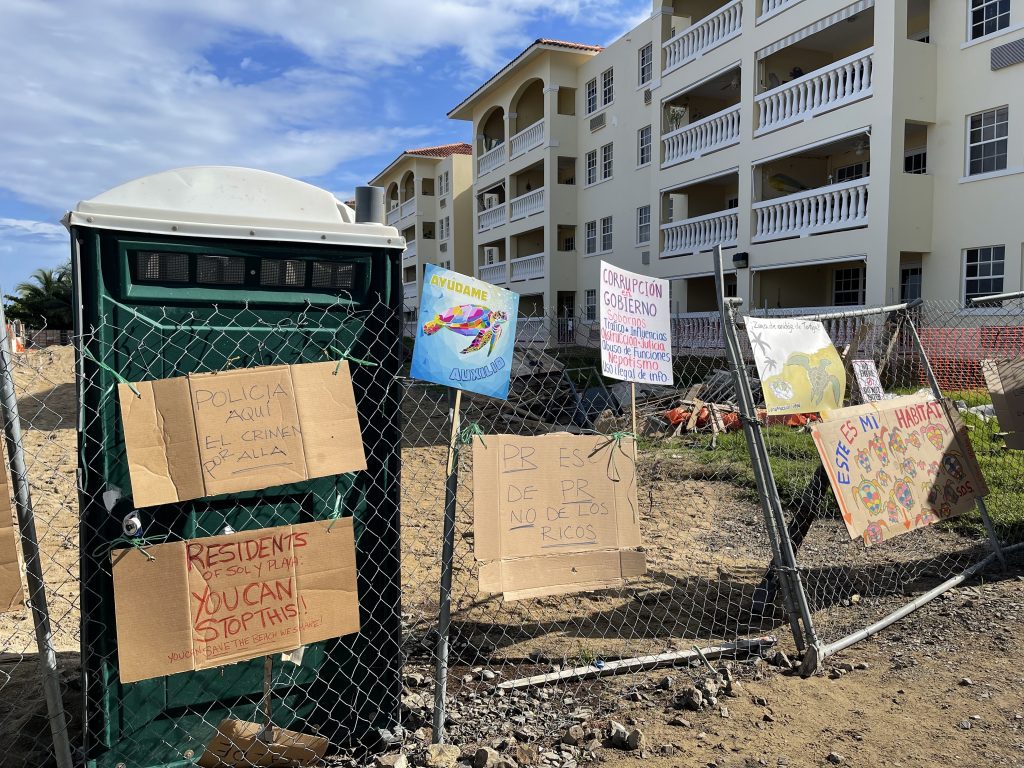
A cousin of Governor Pierluisi was a resident of the condo that was trying to build the swimming pool.
Elsewhere in Rincon, an assortment of community groups and local businesses built a hiking trail along the beach near the marina underneath some palm trees to stave off a threatened hotel development. Signs along the trail and through the town read, Salva Tres Palmas, No Destruyas Rincón (Save Tres Palmas, Don’t Destroy Rincón).
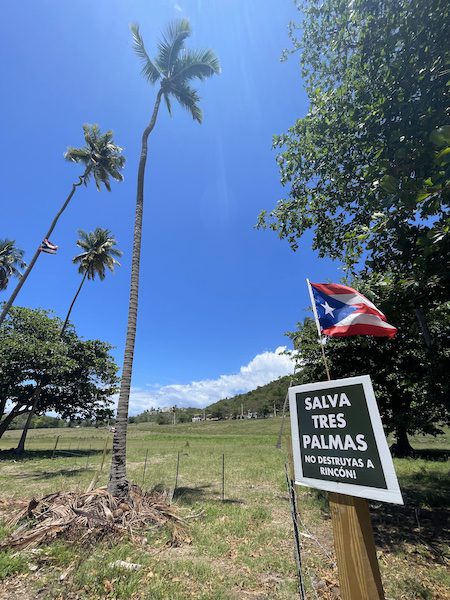
Destination management, in terms of developers seeking financial incentives for large projects such as hotels, would be the responsibility of the Puerto Rico Tourism Company. Its CEO didn’t respond to an interview request.
Responsibility for destination management also falls to the Department of Natural Resources and local municipalities in terms of permits and enforcement.
Felix Salas, the Puerto Rico-born surveyor, is familiar with encroachment issues where people were trying to illegally acquire federal land on Culebra, one of the two bigger islands along with Vieques that are part of Puerto Rico.
“So they’re in the maritime terrestrial zone where you’re not supposed to do anything, really,” Salas said. “And that’s a public domain. It was a pretty straightforward case, but we realized that Puerto Rico needs a lot more attention from our headquarters and from all federal agencies.”
Tomás Ramírez, Discover Puerto Rico board vice chairman who heads the Asociación de Paradores y Pequeñas Hospederías Puertorriqueñas (the Association of Paradores and Small Inns) in Cabo Rojo on the island’s southwest coast, acknowledged there has been a problem “with some people taking ownership of the beaches. We have had some large developers purchasing properties near the beach and closing access.”
Ramírez, who also owns the Combate Beach Resort in Cabo Rojo, said there are some Airbnbs in places they should not be. “However, it is not a large problem yet,” he claimed.
The Puerto Rico Tourism Company, the natural resources agencies and local officials weren’t doing adequate jobs in safeguarding the island’s development. He contended things are improving, though.
“It was a matter of execution and enforcement,” Ramírez said. “It is happening.”
Community Engagement and Dispersing the Island’s Visits
Skift Editor-at-Large Lebawit Lily Girma has written several articles about how Panama tourism, and tourism officials in Hawaii, are in the forefront of those seeking to connect local communities to tourism strategy.
Ramírez said engagement with local communities is happening “little by little” in Puerto Rico. Discover Puerto Rico has a local advisory committee that includes the presidents of the Chambers of Commerce of the south and west regions, as well as the director of the Universidad Ana G Méndez Kingbird Innovation Center, and the owner of LT Travel Agency, for example.
He said Discover Puerto Rico has met with legislators, mayors and community groups in municipalities such as Cabo Rojo, Ponce, Aguadilla, and Lajas, for instance.
Some raised concerns about the quantity of tourism — they want more — and some of the mayors have favorite tourism projects, Ramírez said. Municipal officials are sometimes also angry about visitors behaving badly.
Ramírez said Discover Puerto Rico is “using strategies to filter such behaviors.”
He pointed proudly to the fact that around 90 percent of Puerto Rico’s off-island marketing used to be directed toward visiting the San Juan metro area or beach vacations, and that now 30-40 percent of promotions go beyond the corridor from Dorado to Fajardo.
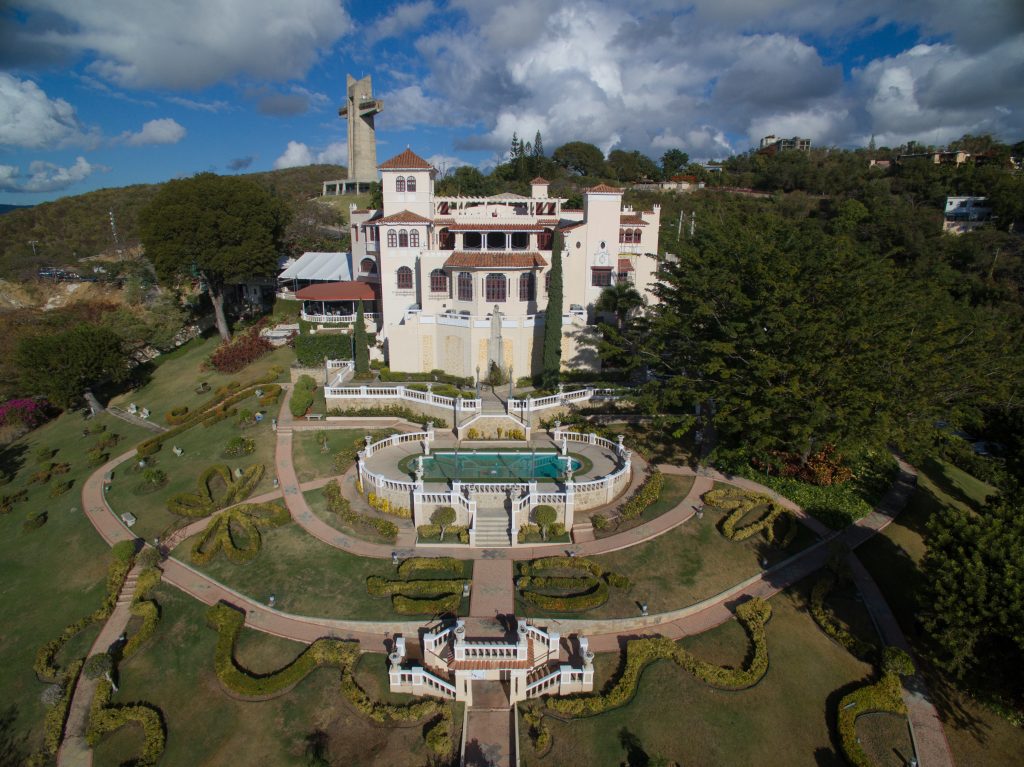
The challenge is to get tourists out of the San Juan area to visit places like Castillo Serralles in Ponce in the south or the Toro Verde adventure park in the central portion of the island.
“So that dispersion, I think to me, is part of the story,” Dean said. “It’s not only more visitors, it’s spreading them out, which, of course, you can look at that in different ways. One, that’s hopefully helping prevent overtourism. The other side, to me, is it’s bringing everybody to the party. Whereas, historically, tourism had been concentrated in certain areas.”
Another side of the coin — yes, Puerto Rico uses U.S. currency — is that the island’s visitors come primarily from the U.S. east coast, namely from New York to Florida.
Discover Puerto Rico hopes to attract more guests from the U.S. Midwest, and eventually the U.S. west coast. International arrivals have been largely shut down until recently, but the destination management organization began marketing abroad a couple of weeks ago.
As part of that strategy to attract visitors from the U.S. mainland beyond the east coast, Dean said Discover Puerto Rico is using different versions of the Live Boricua campaign for varied audiences.
“There are some markets that know us fairly well, like New York and Florida,” Dean said. “They immediately resonate with Live Boricua. They’re familiar with us and they want that deep intrinsic connection, an emotional connection. They’re craving that. Then there’s other markets like my friends in Indianapolis or Peoria, Illinois. They want it too, but they don’t know us well enough yet. This is the first date. They want to get to know us a little better. They probably need to see some beaches and some of the traditional shots.”
Jobs, Jobs, Jobs But What Kind?
As part of its tourism recovery, Puerto Rico is now attracting meetings and conventions at twice the pact of pre-pandemic levels. Some $400 million worth of meetings and conventions is already booked, according to Discover Puerto Rico, including annual gatherings this year or in 2023 for the U.S. Travel Association, American Society of Travel Advisors, the National Association of Travel Journalists, and the Caribbean Hotel Tourism Association.
Although jobs in leisure and hospitality reached a record 86,000 through April 2022, according to the U.S. Bureau of Labor Statistics, there still is a labor shortage.
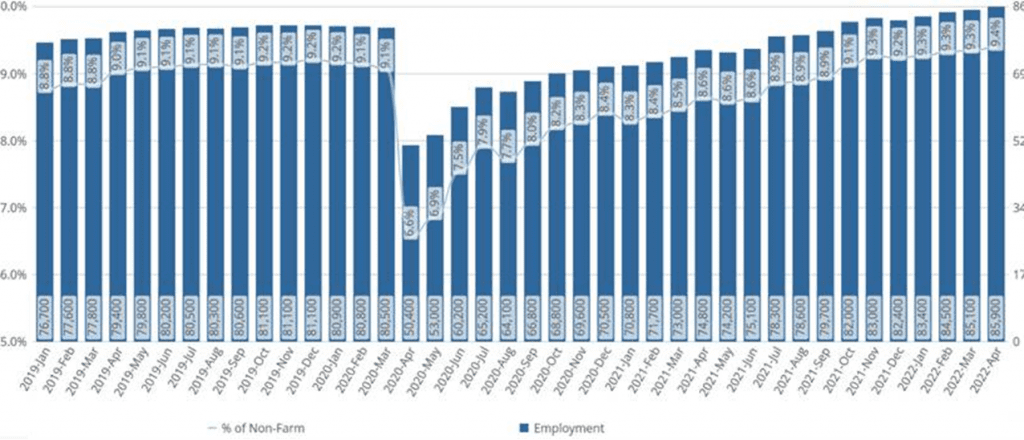
“And maybe the most important stat of all, to me this is probably the one that’s the most surprising, as of today, we have more people employed in leisure and hospitality than ever in the history of the island, which is pretty interesting, because if you talk to local businesses, they’ll tell you they don’t have enough people,” Dean said.
For Puerto Rico born and raised Felix Salas, it all depends on the types of jobs and the economy that the Puerto Rico government, flush with mismanagement and corruption, is creating.
“So I think tourism for an island, it should be one of the top economic methods of having a healthy economy, as long as it’s done right,” Salas said. “As long as the people in Puerto Rico are working for good paying jobs and get fair incentives for what they do, I think it’s absolutely fine.”
But Salas thinks there are downsides to Puerto Rico tilting too heavily toward a services economy. He’s like to see the government and private business help to develop the island’s agriculture potential, for example.
He doesn’t want Puerto Rico tourism to eventually resemble the Dominican Republic where all-inclusive resorts with low-paying jobs are common.
“Because you’re going to have people making little money just to serve people who come here who have the money,” Salas said. “So you do want to diversify the economy a little bit more. I think that is the way to the future. I think it should be something that we should work hard on. I feel like that would make it a bit more independent.”
Dean of Discover Puerto Rico probably wouldn’t disagree.
“There are massive changes in the workplace and the workforce, and major infrastructure needs, which in many instances our country has not addressed, at least not to the level we need,” Dean said. “These are major challenges that the best marketing plan and sales team in the industry can’t overcome.”
In that regard, Dean argues that the old destination marketing organization model of placing ads and selling inventory is an anachronism.
“I think it’s a challenge at the same time for us to step up and recognize that we have a role in the economic strength and prosperity of our communities,” he said. “But that means recognizing that we’ve got to be at the table, helping solve issues that, while they may not appear as the top priority for us, they’re important to the community. If you can’t be at the table helping solve your community’s problem, then A, you’re not a part of the team, and B, it’s going to impede your ability to drive progress in your community.”
Lessons From Puerto Rico Tourism
Among the lessons one can glean from Puerto Rico tourism:
- Discover Puerto Rico, mostly out of necessity because of the tourism industry’s weak financial position at the time, tossed out the usual membership funding model that sees many tourism boards dominated by the narrow interests of hotels, for example. Airbnb is a big part of Puerto Rico’s tourism comeback, and the destination management organization may have been hampered had the hotel industry been the only party calling the shots. Puerto Rico offers attractions and restaurants free directory listings, but their impact isn’t gargantuan.
- Yes, it’s great to see when tourism board leaderships aren’t solely made up of political appointees here today and gone on Wednesday to bring a degree of consistency to strategy. But will private businesses adequately safeguard the public interest?
- If tourism boards don’t make engagement with local communities a big priority, they too can get swept away in a backlash as fast as a governor who reveals his true character with associates in a seemingly private chat.
- In this current era, tourism, living and social issues are one big splotch of paint, and each will color the other, and can’t be separated.
- Hire the best and the brightest, and employees who value diversity and inclusion, whether for content creation or supplier relations. Everyone will not always get along in any collection of human beings, but doling out the best jobs to an exec’s cousin or nephew won’t cut it when the public measures your every move.
- Let your decisions be research driven or at least research influenced as a core practice. If your research tells you your brand positioning isn’t much different than for any other Caribbean island or country in Southeast Asia, then it’s time to change your message and perceptions — based on your research.
- Don’t crawl into a bunker during the next crisis — and there will inevitably, yes guaranteed, there will be one. Use the time to retool and stay in the consideration set, circumstances permitting.
- Trust your instincts but consult with others about ever-changing consumer behavior or patterns. Otherwise you will be left behind as fast as a wind gust from a Cayey mountaintop overtakes you.
- After all, complacency is death.
Editor’s Note: The author, Skift founding editor Dennis Schaal, has lived in Puerto Rico since November 2020.
Disclosure: Skift founder and CEO Rafat Ali serves on board of advisors for Discover Puerto Rico.
Correction: The Jones Act only pertains to goods that Puerto Rico imports from U.S. ports, and we incorrectly reported that it covers all global imports.
The Daily Newsletter
Our daily coverage of the global travel industry. Written by editors and analysts from across Skift’s brands.
Tags: airbnb, airlines, destinations, discover puerto rico, DMO, hotels, jobs, marketing, puerto rico, puerto rico tourism company
Photo credit: A screenshot from Discover Puerto Rico's Live Boricua marketing campaign. Discover Puerto Rico Raquel Pedrosa / Adobe

